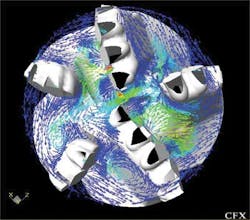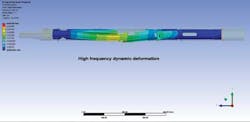Simulation and sensors advance the digital oilfield
Ahmad Haidari
ANSYS
As the oil and gas industry looks to increase production from old fields and deepwater reservoirs, the vision of the digital oilfield is highlighted as a potential solution to many of the challenges presented by higher temperatures, higher pressures, longer tiebacks, and more expensive operations.
In fact, digital oilfields have been estimated to tap an additional 125 Bbbl of oil by 2015. Currently, control rooms can and are monitoring and optimizing operations of sites thousands of miles away.
This creates opportunities to improve processes, have advanced warning about product performance, and manage assets with real time field information. The hundreds of terabytes of information collected and analyzed in these control rooms everyday provide operations with intelligent data that ultimately will improve drilling, production, and operation across the supply chain. The digital oil field is taking root.
It is no surprise that electronic devices, sensors, controllers, and wireless connections are changing the industry's drilling practices and technologies. One example is the integration of advanced electronic sensor technology into downhole and drilling operations. Data generated by sensors provides invaluable insight to engineers and operators to determine how to best drill as well as how best to operate subsea facilities for maximum return.
Deploying sensors and developing products that respond and operate with embedded sensors lead to products that could have additional components, smaller sizes, and novel materials. Therefore, many factors must be addressed to ensure seamless, successful operation before the sensors can be placed in the well and drilling can begin. Factors include accurate sensor positioning, the signal and product integrity of the sensors, and the response of the equipment to control and operating conditions.
These are new challenges, so product development practices in many engineering and R&D departments must evolve to keep pace. Leading oil companies are extending capabilities and refocusing product development processes to take advantage of three enabling activities to meet these new challenges within their engineering and R&D divisions:
- Detailed integrated multi-physics engineering simulation (early in the design process)
- System design
- Smart product developments that incorporate embedded software.
Engineering simulation
The growing development of drilling and evaluation and completion technologies influences the way engineers drill wells. They now have access to informative intelligence and data that help with more efficient and smarter drilling. These sources include electronics and sensors which help accurately direct and control drill bit position while logging and measuring. This not only reduces nonproductive time, but also leads to faster drilling rates and helps reduce damage and drill wear. These electronic sensors need to withstand thermal, vibration, and impact damage.
New design practices must account for product performance over the life of the equipment. For instance, the sensors and drill tools need to be subjected to real-life conditions of vibration, fatigue, high temperatures, and interferences from other equipment and electronic signals before reaching the field for commercial application. To do so, engineering teams are shifting from a component, or subsystem view, to a higher-level perspective that considers performance at the complete systems-level – applying multiple physics, multiple scales, and a collaborative, cross-functional engineering approach early in the design stage. By modeling systems-level interactions and product responses to multiple forces, engineering teams are able to rapidly and continually fine-tune the entire product system and to predict systems-level performance in a virtual environment well before physical assembly and testing.
Today, advanced engineering simulation tools can evaluate both single components as well as the interactions among components and subsystems of the entire design using single and multi-physics simulations. These science-based engineering tools include electronics, electromagnetics, fluids, and thermal and structural mechanics simulation technology. With these tools, oil and gas companies can model well, drilling, and sensor designs with a high degree of detail and fidelity even with complex geometries and complex physics.
Flow assurance and vibration
For example, post-processing results from a fluid mechanics simulation of drilling mud flow at the surface of a drill bit can give insight into its cooling and cuttings removal performance. This performance can be optimized when there is a better understanding of the flow pattern and the velocity magnitude for a given drill bit and cutting speed. While the drill bit simulation is a static, single physics simulation, it can also include additional components such as transient and dynamic response. Dynamic vibration forces on a downhole tool and/or sensor are another factor that must be modeled to ensure the durability of electronics such as a printed circuit board assembly.
Electromagnetic analysis
Understanding the formation properties and environment of the oil wells is critical to successful drilling. An oil company must factor in the depth of a well and design appropriate downhole tools and sensors that can handle the expected environment. One area where sensors play a crucial role in drilling is logging while drilling (LWD). There are three important LWD engineering tasks that require electromagnetic simulation analysis:
- LWD antenna design to maximize sensitivity for complex three-dimensional drill bit trajectories into complex formation layers while accounting for realistic environmental conditions such as antenna shape, mandrel affect, borehole effect, mud invasion zones, anisotropic formation properties, and mandrel eccentricity.
- Parametric study of tool and environmental variables to enable rapid interpretation of complex logs, allowing operators to quickly interpret operating conditions and adjust equipment as needed.
- LWD antenna electromagnetic characterization for compatibility with receiver/transmitter electronics to maximize signal integrity and to ensure the tool never operates "blind" in the field.
These engineering design issues require 3D electromagnetic field solutions together with electronics system simulation to provide design capability and system validation. The 3D tool can be optimized electromagnetically in a virtual environmental formation to look at the antenna design and expected effects on measured logs.
While new to the oil and gas industry, the underlying computational technology used to perform these examples shown are deployed widely in other industries. For example, the electromagnetic field calculations for low-frequency are used in the design of electric machines, alternators, transformers, and other high-frequency electromagnetic applications may include simulation of antennas, cell phones and tablets, biomedical devices, radar systems, and many others.
Embedded software
It is clear that the oil and gas industry is using more advanced electronics and is operating more equipment and plants remotely. The underlying power controlling the behavior of the electrical, mechanical, and fluidic systems driving the digital oil fields is embedded software. The embedded software manages the complex interaction between software, hardware, and human/machine interfaces.
For a new design, a system-level simulation approach combined with verifiable methods to help model the behavior of the hardware and the software before it is implemented enables engineers to gain insight into the performance of the well, downhole tools and sensors, and their controllers before they are implemented. For existing systems, and with sensors already in place, the real-time field data can be combined and even help drive detailed 3D simulation to perform root cause analysis, identify improvement opportunities, and to enhance the controllers and reliability of product and processes.
Technology is changing operation and processes in many oil and gas fields. There are substantial investments in R&D and engineering behind every safe, reliable, and cost-effective innovation implemented in the field. Increased product complexity and the remote operation and control of oil and gas equipment and processes create new drilling challenges. Detailed engineering simulation, coupled with system-level modeling, is empowering engineers to effectively design and deploy next generation sensors and smart products to gain additional efficiency and reliability in oil and gas drilling, production, and processing.
About the Author
Dr. Ahmad H. Haidari has more than 20 years of experience in the application of engineering simulation and modeling technology to address industrial-process-equipment design, equipment troubleshooting, analysis, and scale up. He obtained his Ph.D. from Lehigh University and has made numerous presentations and written publications on modeling chemical and hydrocarbon process equipment and oil and gas machinery. At ANSYS he is the global director of the energy and process industries, where he ensures full portfolio of ANSYS engineering simulation software provides appropriate capabilities to meet the modeling requirement of energy and process industry companies.
Offshore Articles Archives
View Oil and Gas Articles on PennEnergy.com



